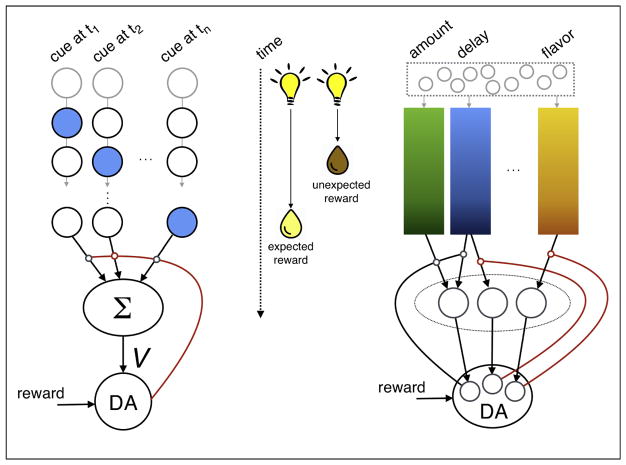Figure 1.
Multiple dimensions of prediction in dopamine prediction errors. Consider a simple task in which a brief presentation of a light cue is repeatedly followed by a drop of vanilla milk after some fixed delay (middle). What would happen on a trial in which the light is followed by a drop of equally-preferred chocolate milk after a shorter delay? Model-free TDRL with a complete serial compound stimulus representation proposes that the cue triggers a discrete sequence of activity that represents sequential time points after the presentation of the cue (left; a number of neurons are depicted horizontally; their activity at different timepoints is portrayed vertically). At each timepoint, summation of this weighted representation produces a scalar estimate of future value (V), which dopamine neurons (DA) compare to obtained reward to compute a prediction error signal. The prediction error is then broadcast widely (red) and used to modify the weights for neurons that were recently active (circles on arrows). When an unexpectedly early, chocolate-flavored reward is delivered, the prediction error signals the difference in time-discounted value, and modifies the weights for the part of the representation that is active when the prediction error is signaled. In contrast, we propose that dopamine neurons have access to (and maybe aid in learning) dimensions of prediction other than scalar value, and these are used for computation and signaling of prediction errors (right). For example, after the presentation of the cue, multiple features of the predicted next event (in this case, a liquid reward) may be represented by (perhaps overlapping) populations of neurons through time (color gradient), including the predicted amount (for example, one drop), the delay to reward delivery (it will arrive after several seconds) and the flavor of the reward (vanilla milk). At the time of reward delivery, violations of the prediction along any of these dimensions may elicit a phasic response from dopamine neurons, though different neurons may be specialized for prediction errors corresponding to different dimensions. In this case, at the early presentation of a drop of chocolate milk, prediction errors are elicited for the timing of reward delivery as well as for flavor (red) but no prediction error arises for amount (black).

